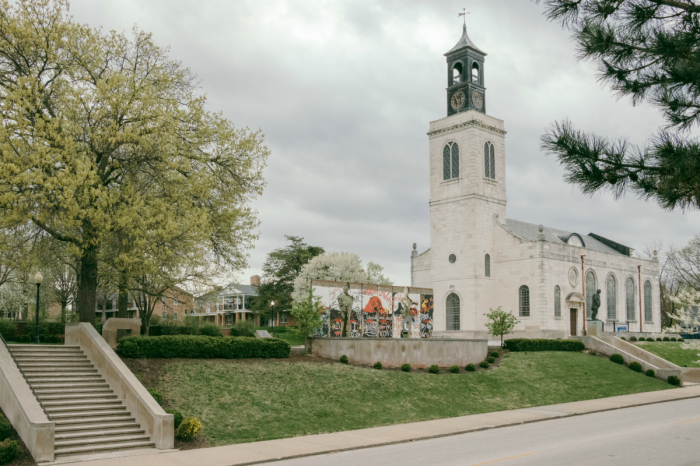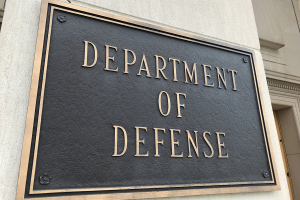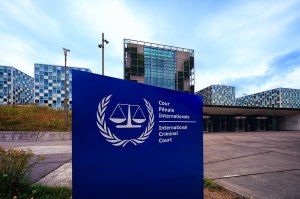How a church bombed by Nazis ended up in Missouri

The tower of this English Baroque church, which overshadows the campus of the small liberal arts college that surrounds it, is rather striking for a college chapel on these shores.
The Church of St. Mary the Virgin, Aldermanbury was designed by Sir Christopher Wren and built after the Great Fire of London in 1666 destroyed the previous medieval edifice. It served the needs of the surrounding parish for three centuries until the Blitz of 1940, when Nazi bombs struck it.
While the walls, made from stately Portland stone, remained standing, the interior was mostly destroyed. As with many of London’s other Wren churches — over 50 churches are attributed to Wren or his workshop — it stood in a ruinous state as British authorities developed plans and came up with money for rebuilding the city. This was a herculean task given that 116,000 buildings were either destroyed or bombed beyond repair.
By the 1960s, some of the churches were reopened after they were authentically restored to their original designs. In other cases they received Wren-esque designs in keeping with the style of the late 17th century. However, St. Mary the Virgin remained a bombed out ruin.
Around the same time, Westminster College, a historically Presbyterian college, was looking to honor Sir Winston Churchill’s 1946 speech on its campus in Fulton, Missouri.
It was remarkable that Churchill — despite being no stranger to the American speaking circuit — would visit a college in a small town in the middle of nowhere. Of course, it helped that Westminster College’s audacious invitation had the support of President Harry Truman, a native Missourian.
Churchill used his speech, officially titled “Sinews of Peace” but more commonly called the “Iron Curtain,” to warn of the Soviet Union’s postwar expansionism and what later became the Cold War. Adding to its significance was the very presence of Truman, who attended even though Churchill was no longer British prime minister.
Nearly 20 years later, Westminster College decided to purchase and rebuild St. Mary the Virgin. The invitation to Churchill was certainly audacious, but this project was on a completely different scale.

First, what remained of the church had to be meticulously chronicled stone-by-stone before deconstruction. It was then shipped across the Atlantic with the 7,000 stones used as ballast before traveling by rail to Fulton. Then it had to be reconstructed with an interior faithful to Wren’s original design.
Three years later, in 1969, it was reopened with considerable pageantry that somewhat ironically — Westminster College being Presbyterian in establishment — included rites by an Anglican bishop. Lord Mountbatten, the war hero and last viceroy of India, was even sent by Queen Elizabeth II as her representative.
Over the ensuing 50 years the church evolved from a memorial into the National Churchill Museum that exists today.

Located in the undercroft of St. Mary the Virgin, the museum tells the story of Churchill’s fascinating life as a historian, journalist, politician, soldier and statesman. Then there is the church, which rivals any of the famous Wren churches in London, most of which are also restored. Somewhat thankfully, it is still used for religious worship. Outside on a plaza stands a sculpture by Edwina Sandys, a granddaughter of Churchill, made from eight sections of the Berlin Wall.
What makes the National Churchill Museum most impressive is its location. You expect such a museum somewhere in England, not in Missouri. Westminster College has punched well above its weight.
Even if you can’t make next weekend’s grand 50th anniversary celebration, which includes a keynote speech by the acclaimed historian and commentator Andrew Roberts, a visit to Fulton is a must for anyone wanting to better understand not only Churchill but also the Cold War.
If you go
The National Churchill Museum is open daily between 10 a.m. and 4:30 p.m. Tickets range from $6.40 for teenagers and college students to $8.50 for adults.
Fulton is about 90 minutes by car from St. Louis and the closest major airport. I stayed at the Loganberry Inn, a bed-and-breakfast whose past guests include Margaret Thatcher.
Spires and Crosses, a travel column exclusive to The Christian Post, is published every week. Follow @dennislennox on Twitter and Instagram.





























